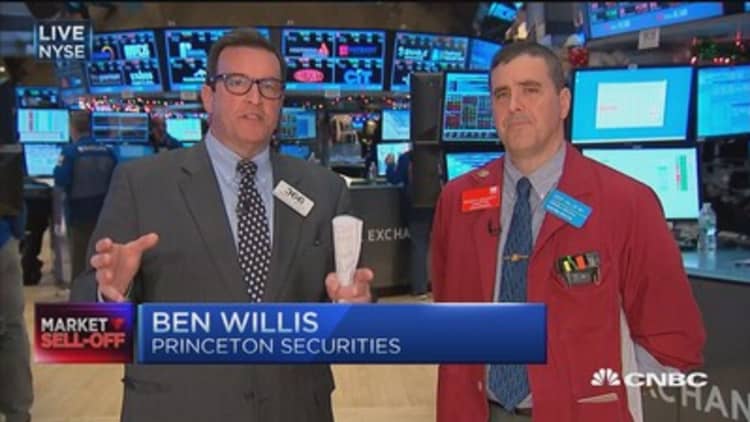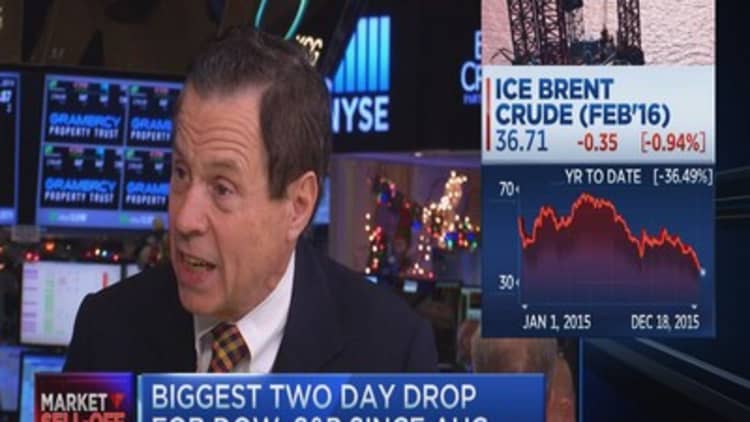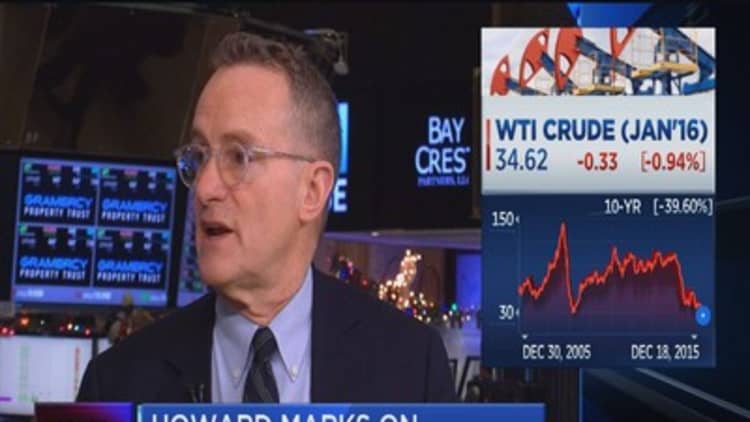


Traders may be robbed of their Santa rally this year.
After weeks of volatility, the stock market's 2015 performance may come down to the price of oil in the final days of the year.
U.S. oil futures for January fell 2.5 percent in the past week, and the wild swings in both directions took a toll on the stock market. The Dow lost 0.8 percent for the week to 17,218, while the S&P 500 lost 0.3 percent to 2005. The Dow fell more than 2 percent on Friday, the second-highest volume day of the year due to derivatives expirations.
Read More This indicator may mean more trouble for crude oil
Stocks were also flustered by the Fed, which raised its fed funds rate Wednesday by a quarter-point, after seven years near zero. Stocks initially rallied, but the market headed lower and bond yields slipped as investors worried that the Fed's forecast for four rate hikes for next year was too aggressive in the face of mixed economic data.
"I think the violence of the move and the quickness of the moves are scaring investors, but if you stand back and look at a chart, it doesn't look that scary," said Steve Massocca of Wedbush Securities. "If (the S&P 500) breaks through 1994, then I do think we make a run all the way back to the September low of 1,871.
"I think energy prices are an issue. I don't see (the S&P) breaking that September low," he said. "We're going to be in a trading range. The economy's not all that bad. It's really just bleh. There's no growth. I think rates are low enough and the Fed is hiking slow enough that stocks aren't going to get killed. I don't think it's baked in the cake that (fed funds) are going to 1 percent."
Read More Flat stock market bodes well for 2016: History
Massocca said stocks could be steadier in the next two weeks, but they are not likely to rally hard enough to put the S&P back into the green for the year.
"I think a lot of the tax loss selling is going to get out of the way. I think it's already done. I don't know who is going to go in now," he said, adding he expects to see down to sideways trading. The S&P 500 was down 0.3 percent for the week, but it is now down 3.7 percent for the month and 2.6 percent for the year.
In the coming week, there is third-quarter GDP data and existing home sales Tuesday, and durable goods and personal income and spending on Wednesday. The market closes early Thursday and is closed for the Christmas holiday Friday. Oil will be a factor, as there could be volatility around the expiration of the front month futures contract Monday.
The year end is more often than not a positive time for stocks, and traders mostly expected the same this year. But oil has had a tight grip on financial markets, at the same time the Fed stepped out to raise interest rates. The combination in the past week was toxic for stocks. Investors feared falling commodities prices would create deflation, and a string of mixed economic data means the Fed's hiking could become a problem for the economy.
"Normally we have a bit more confidence in the economy than have this time around. This is a hike into stress. The stronger dollar and lower oil are creating stresses that the Fed is putting into the camp of transitory factors. Right now, they're not feeling so transitory. They're feeling entrenched right now," said Leo Grohowski, chief investment officer at BNY Mellon Wealth Management.
Read More Trader: Buy these bank stocks on higher rates
The dollar index is up nearly 10 percent for the year, and it has bit into earnings growth which turned negative last quarter. West Texas Intermediate crude futures for January closed down 22 cents at $34.73 per barrel, and while it showed some strength at the end of the session, it was not viewed in any way as a bullish settle. The contract rolls on Monday and markets will be watching the February contract which is trading about higher and closed at $36.06
"I don't think it's the Fed," said Russell Koestrich, BlackRock global chief investment strategist. "Oil is more about the high-yield market. Credit spreads are widening out and that's disturbing to investors. This was a disappointing year for earnings. That's something that concerns people. A large part of that was dollar driven. That's a head wind for earnings.... Of the different factors, I think the strengthening of the dollar is arguably the bigger threat to corporate earnings rather than whether the Fed goes two or three times."
The high-yield market continued to suffer in the past week, with the Bank of America Merrill Lynch high-yield spread just above 700. It reached that level on Dec. 10 for the first time since 2012. According to Bank of America ML, the spread was at 640 at the beginning of December. If energy is excluded, the spread would be 619.
High yield has been hit across the board but commodities and energy are the worst areas.
"Some of the better-quality companies already appear to have sufficient liquidity to last for the next couple of years," said Adam Leight, high-yield energy credit analyst at RBC. "At the other end of the spectrum, there's a large cohort of companies that have bonds trading at very depressed, distressed levels." He said that of 68 oil and gas producers he follows, almost a third have bond trading at 30 cents on the dollar or less and 43 percent are at 40 cents or less.
Read More Santoli: Will the 'great rotation' ever pan out?
Leight and other analysts say capital will be harder to come by for some companies if prices don't get better and more bankruptcies and consolidations are expected.
"Pretty much everybody is going to need some kind of price recovery. Even the guys that have good assets and can last a couple of years, there's not that many that can last with $35 oil and $2 gas," Leight said.
More pain is coming even if oil prices stabilize. In an era of easy money, the energy industry was able to issue debt freely when it was booming, and continued to do so even as oil prices fell. "We had a multi-year party while the parents were out of town, now we have to clean up," said Leight.
Analysts see no rebound for stocks either unless oil stabilizes, and the worry is that the high-yield market is sending a warning.
"I think a lot of securities are being painted with a brush that is discounting oil below $30. … We are hearing that word contagion," Grohowski said. "When you have oil, high yield, emerging markets contagion, there's a fair amount of nervousness built in. The (stock) market's fairly valued. Markets aren't going to tolerate mediocre news and they're going to behave with more volatility than what we're accustomed to for the last six or seven years. It's going to be a more volatile period with less attractive returns."
Read More Gold is still going to $5,000: Peter Schiff
But Grohowski isn't all that negative, and he sees the S&P between 2,100 and 2,250 at year end 2016. "I'd be a buyer. There's a lot of cash on the sidelines. I think the Fed gave us what the market expected," said Grohowski. "I don't find valuation overly challenging. I think I'd be a buyer before a seller, not just before the end of the year, but thinking about the next 12 to 18 months."
He said the fact that his target for 2016 is such a wide range "shows our uncertainty in expectations of volatility, so the midpoint is 2,175. We're buyers before we're sellers, but we're not aggressive buyers."
Koestrich is also not negative on the stock market though he said investors should also be positioned internationally.
"I think it's really going to depend on the economic cycle. We're past the point where the Fed is going to be able to push up multiples much," he said. Koestrich said if the dollar stabilizes, earnings will be stable. "I think 2016 will be a better year. The rapid appreciation we've seen since 2014 has been a real drag on earnings," he said. He expects single-digit gains in stocks next year, and his target is 2,150 to 2,200.
What to watch
Monday
8:30 a.m.: Chicago Fed National Activity Index
Tuesday
8:30 a.m.: GDP Q3
9 a.m.: FHFA home prices
10 a.m.: Existing home sales
Wednesday
8:30 a.m.: Durable goods
8:30 a.m.: Personal income
10 a.m.: New home sales
10 a.m.: Consumer sentiment
Thursday
Stock market closes at 1 p.m.
8:30 a.m.: Initial claims
Friday
Christmas Day holiday
Markets closed


